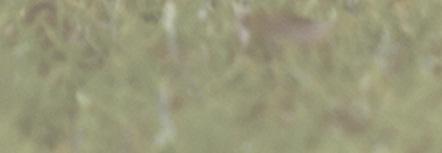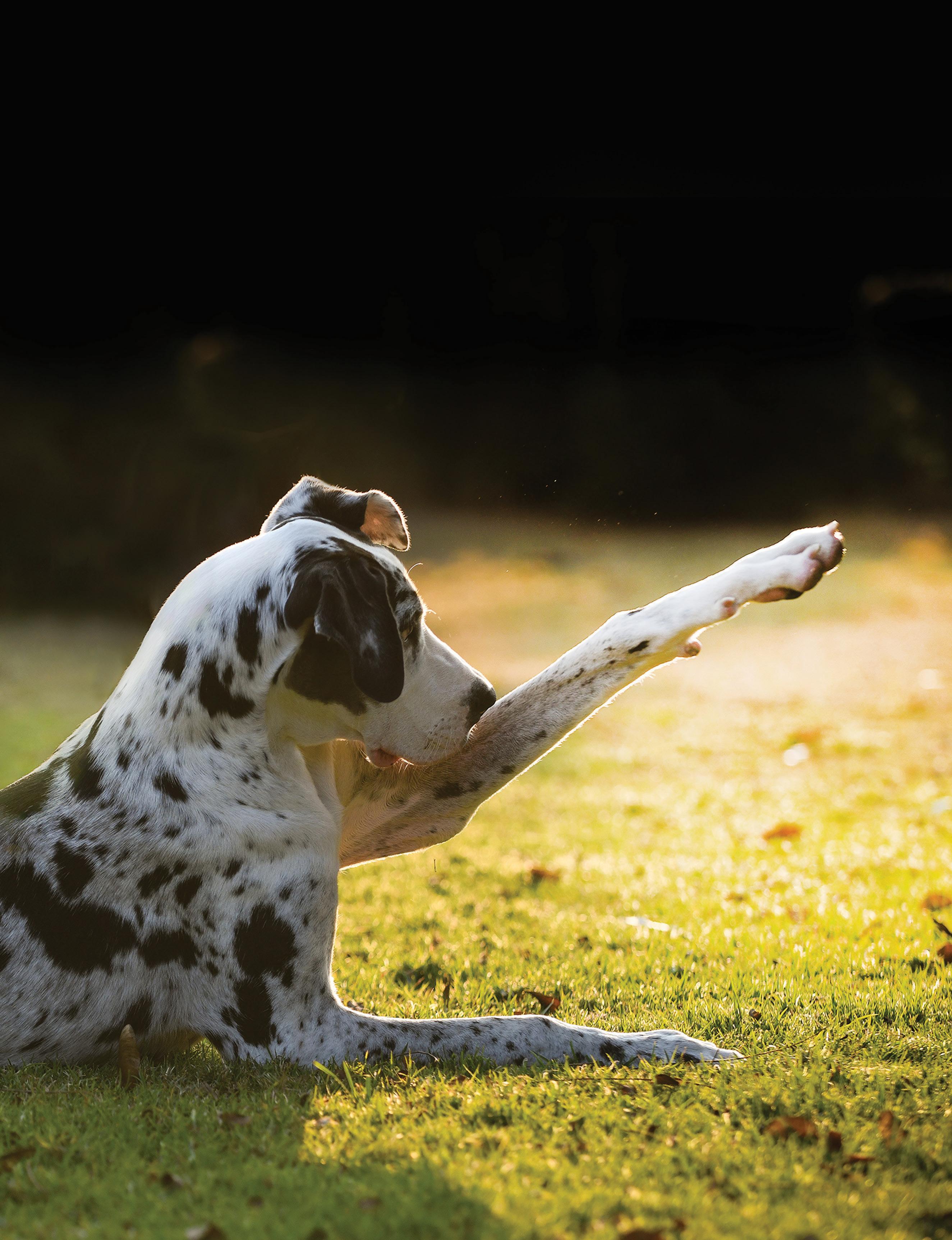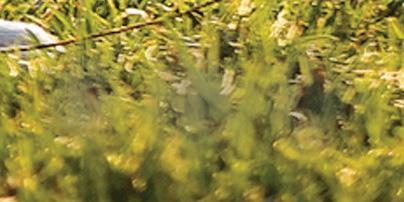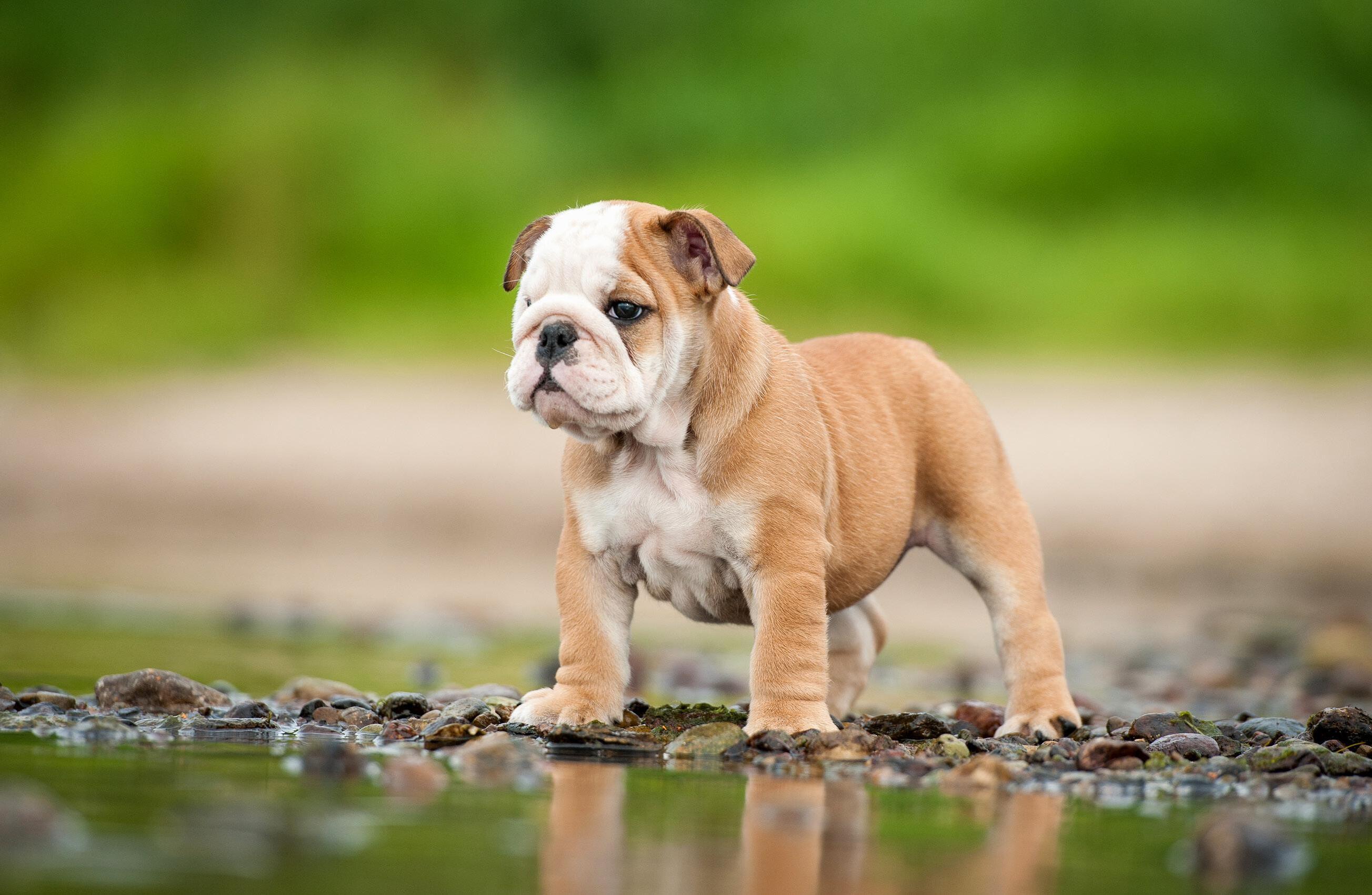
DIGITAL ISSUE 9A | 2024
SOUTH AFRICA’S PREMIER DOG MAGAZINE

CHOOSE AWARD WINNING
JOHANNESBURG | PRETORIA | CAPE TOWN | GARDEN ROUTE | DURBAN www.paleopetpure.com & Services Pet Products awards 2023 LUXlifeMAGAZINE TEPWARTSEB F OOD MANUFACTURERSOUT H ACIRFA
RAW PET FOOD
Hello and welcome to our latest issue of DQ Magazine!
It’s great to have you with us for another edition.
Our breed of the month is the English Bulldog, and we’re just obsessed with these unique, ever-so-cute canines. Then, with an article on Crufts, featuring the spin-off Scruffts, as well as pieces looking at your dog’s (not so gourmet) sense of taste, their need for sleep and the care they require in their senior years, we hope you’ll find something here to pique your interest.
Until next time,
Lizzie and the DQ team
Dr Lizzie Harrison | Editor
DQ | 8C 3
Designer: Anne Royden-Turner
xxx
CONTENTS
The English Bulldog
Gentle hearts, courageous spirits
Heritage and history intertwine
The tale of a 160-year-old indigenous dog called Mutton
Catching up on Crufts
The greatest international dog show
Why is the American XL Bully being banned?
In England, Scotland and Wales
Embracing the golden years
The art of caring for a senior dog
Parting paws
Ensuring your dog's well-being when you go away
Unravelling the mysteries of canine slumber
Understanding your dog's sleep patterns
The freedom of hands-free
How to choose and use a hands-free dog lead
Decoding the canine palate
A dog's sense of taste
Ask DQ
Your questions answered
Products we love
DQ | 8C 4 DIGITAL
9A | 2024
ISSUE
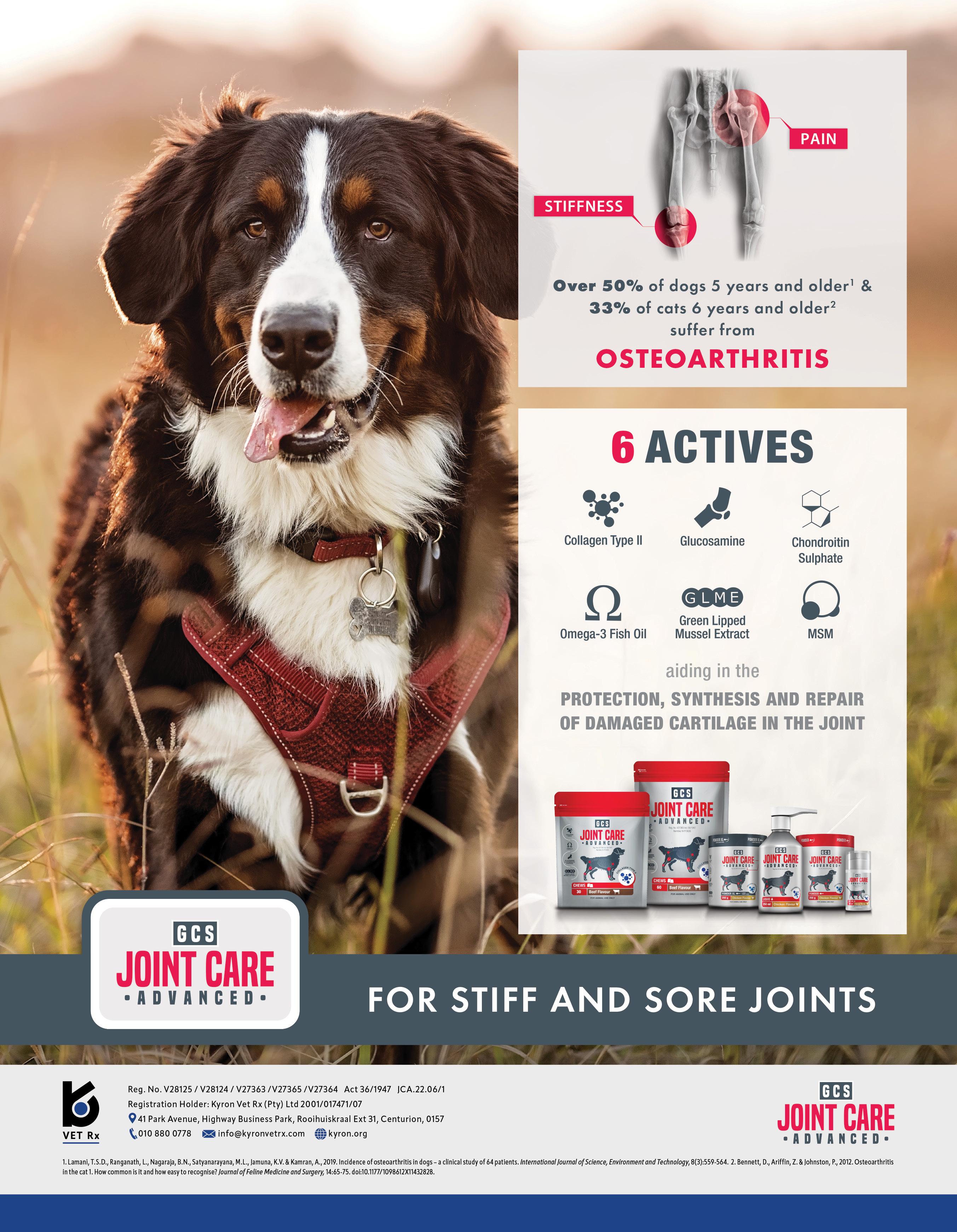

DQ | 8C 6
PROFILE
BREED
The English Bulldog
GENTLE HEARTS, COURAGEOUS SPIRITS
DQ | 8C 7
BREED PROFILE
The English Bulldog, with its distinctive, wrinkled face and stout, muscular body, is one of the most recognisable and beloved dog breeds. Despite their somewhat fierce appearance, Bulldogs are known for their gentle, affectionate nature and make excellent companions.

DQ | 8C 8
BREED PROFILE

ORIGINS AND HISTORY
The English Bulldog's history traces back to 13th-century England, where they were bred and used in a cruel sport known as bull-baiting, which involved the dog latching onto a bull's nose and roughly wrestling it to the ground. The breed's strength, tenacity, and distinctive jaw structure were all attributes developed for this purpose. Thankfully, bull-baiting was outlawed in 1835, and the breed was transformed from a fierce competitor into a gentle companion through selective breeding. Today's English Bulldog bears little resemblance in temperament to its ancestors but retains the courage and determination that were bred into it for centuries.

DQ | 8C 9 BREED PROFILE
PHYSICAL CHARACTERISTICS
English Bulldogs are medium-sized dogs with a low-slung, muscular body, broad shoulders, and a massive head. Their face is their most recognisable feature, with an underbite, folds of skin (wrinkles), and drooping lips. They have a short, smooth coat that comes in various colours and patterns, including red, white, fawn, and brindle. Despite their tough appearance, Bulldogs are known for their expressive eyes that convey a wide range of emotions, from determination to affection.

DQ | 8C 10
BREED PROFILE

DID YOU KNOW?
Bulldogs are a popular choice for school and university mascots across the United States, symbolising resilience and tenacity. Notable examples include Yale University's ‘Handsome Dan’ and the University of Georgia's ‘Uga.’
DQ | 8C 11
BREED PROFILE

TEMPERAMENT
Bulldogs are known for their calm, courageous, yet friendly disposition. They form strong bonds with their families and are particularly good with children, often showing remarkable patience and gentleness. However, Bulldogs are also known for their stubborn streak but respond well to consistent, positive reinforcement training. Despite their sometimes aloof demeanour, they are incredibly loyal and seek constant companionship with their human counterparts.

DQ | 8C 12
BREED PROFILE
HEALTH CONCERNS
English Bulldogs face several health challenges, primarily due to their unique physical characteristics. Breathing issues, skin infections in their wrinkles, hip dysplasia, and eye conditions are among the most common health problems. Their flat faces (brachycephalic syndrome) can lead to breathing difficulties, especially in hot or humid weather, making it crucial for owners to monitor their environment and exercise routines closely. Regular veterinary check-ups, a healthy diet, and proper grooming, can help manage these health issues and contribute to a Bulldog's overall well-being.
SNORING

Bulldogs are notorious for their loud snoring, a result of their unique respiratory system shaped by their flat faces and short nasal passages.
DQ | 8C 13
BREED PROFILE
CARE AND GROOMING
Despite their short coat, Bulldogs require regular grooming to maintain their skin and coat health. Their wrinkles need to be cleaned and dried regularly to prevent infections. They also benefit from regular, but not excessive, exercise to keep them fit and prevent obesity, which can exacerbate health issues. Bulldogs are sensitive to extreme temperatures, particularly heat, and should be kept in a climate-controlled environment to avoid overheating.

LIVING WITH AN ENGLISH BULLDOG
English Bulldogs are adaptable to various living situations, making them suitable for both apartment living and homes with yards, as long as they have access to a cool, comfortable space. They thrive on human interaction and do not like being left alone for long periods. Bulldogs are relatively lowenergy but enjoy short walks and play sessions. Future owners should be prepared for a dog that snores loudly, drools, and may be stubborn at times but is also FULL of love and affection.
DQ | 8C 14
PROFILE
BREED

DQ | 8C 15 BREED PROFILE
CELEBRITY OWNERS
Bulldogs are a popular breed among celebrities and public figures, known for their distinctive appearance and loyal disposition. Here are a few famous bulldog owners:
1. Adam Sandler The comedian and actor is a known animal lover and has had bulldogs as part of his family.
2. David Beckham The retired professional footballer has been photographed numerous times with his bulldog, showcasing their close bond.
3. Brad Pitt The acclaimed actor has also been known to have a fondness for bulldogs.
4. Pink The singer is known to have had a bulldog as a pet.
5. Howard Stern The radio

DQ | 8C 16
BREED PROFILE

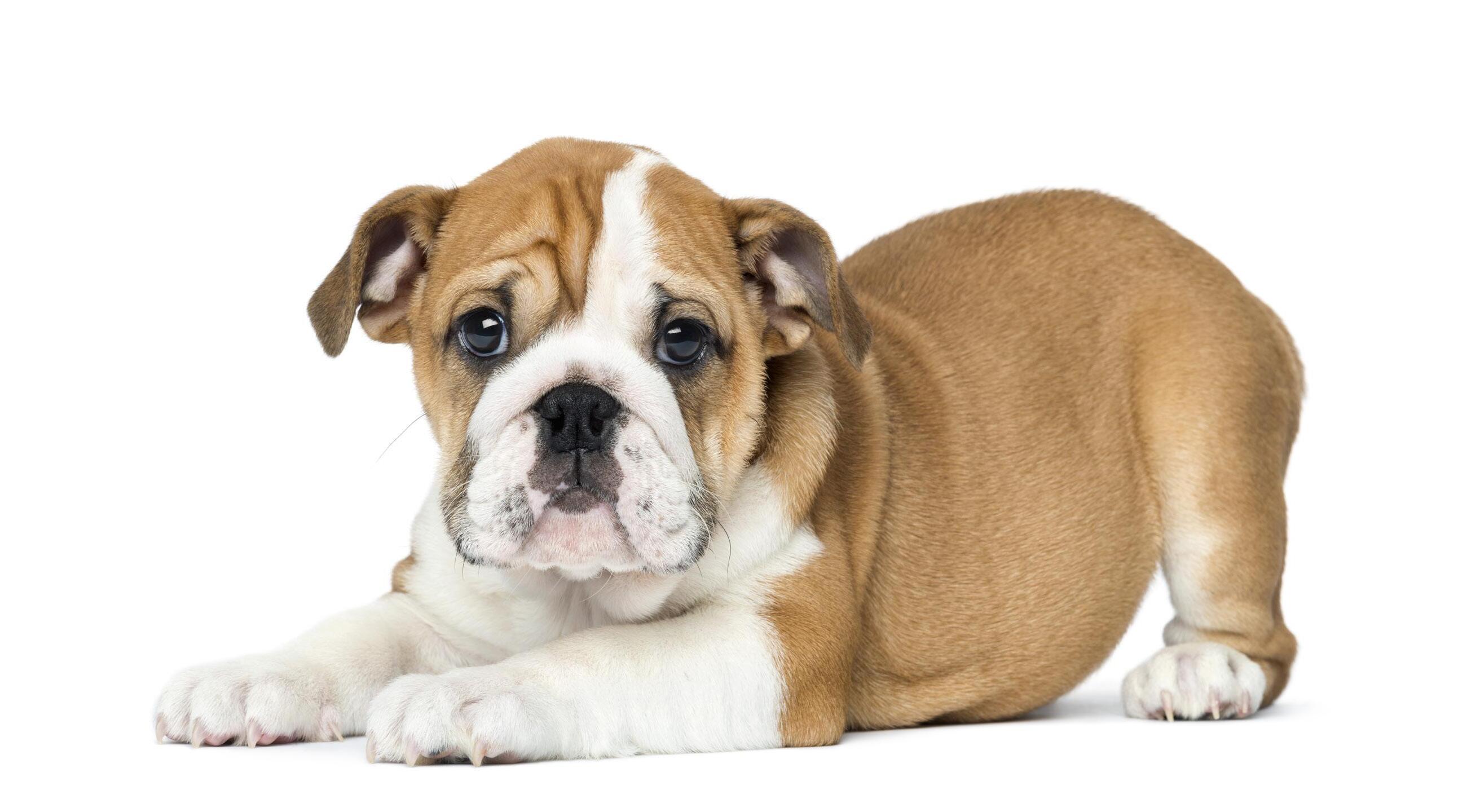
CONCLUSION
The English Bulldog is a breed like no other, with a rich history, distinctive appearance, and a loving, gentle temperament. They make excellent companions for individuals and families alike, offering loyalty, affection, and a touch of comic relief with their unique personalities. Prospective Bulldog owners should be aware of the breed's specific health and care needs, ensuring these dogs live a happy, comfortable life. With proper care, an English Bulldog can be a cherished member of any family, providing love and laughter for years to come.
DQ | 8C 17
BREED PROFILE

Heritage and history intertwine
DQ | 8C 18 FEATURE

THE TALE OF A 160-YEAR-OLD
INDIGENOUS DOG CALLED MUTTON
DQ | 8C 19 FEATURE
In a remarkable confluence of history, science, and culture, researchers and Coast Salish peoples have come together to examine an indigenous dog pelt that is over a century and a half old, preserved within the Smithsonian Museum's vast collection. This collaboration seeks to unravel the mysteries surrounding the origin and abrupt disappearance of the Coast Salish woolly dog, a culturally significant breed whose history is as rich as the fabric of the communities in which it once thrived.
CULTURAL SIGNIFICANCE
Coast Salish tribal nations in Washington state and British Columbia bred and cared for woolly dogs for thousands of years. Prized for their thick undercoats, the dogs were sheared like sheep and often kept in pens or on islands to carefully manage their breeding and to care for the canines' health and vitality. Coast Salish weavers used the dogs' wool to craft blankets and other woven items that served a variety of ceremonial and spiritual purposes. Woolly dogs themselves possessed spiritual significance and were often treated as beloved family members. As emblems for many Coast Salish communities, woolly dogs adorned woven baskets and other art forms.

DQ | 8C 20 FEATURE

DQ | 8C 21 FEATURE

once thriving dog wool-weaving tradition was in decline. In the late 1850s, naturalist and ethnographer George Gibbs cared for a woolly dog named Mutton. When Mutton died in 1859, Gibbs sent his pelt to the nascent Smithsonian Institution, where the fleece has resided ever since. However, few were aware of the pelt's existence until it was rediscovered in the early 2000s.
The intricate investigation of the woolly pelt aimed to shed light on this now-extinct breed of dog. Anthropologists and biologists analysed genetic clues preserved in the pelt of 'Mutton,' the only known woolly dog fleece in the world, to pinpoint the genes responsible for their highly sought-after woolly fur. The researchers sequenced the woolly dog genome and compared it with the genomes of ancient
DQ | 8C 22 FEATURE

determine what set woolly dogs apart. They also identified certain chemical signatures called isotopes in Mutton's pelt to determine the dog's diet and teamed up with noted natural history illustrator Karen Carr to create a life-like reconstruction of what Mutton looked like in the 1850s. Carr's work is the first in-depth reconstruction of a Coast Salish woolly dog in nearly three decades.
interviews contributed by several Coast Salish co-authors, including Elders, Knowledge Keepers and Master Weavers, who provided crucial context about the role woolly dogs played in Coast Salish society. The pelt's age allows it to offer a unique snapshot of the past and a tangible link to the Coast Salish people's ancestral way of life.
DQ | 8C 23 FEATURE
THE COAST SALISH PEOPLES
The Coast Salish is a group of ethnically and linguistically related Pacific Northwest Coast indigenous peoples, living in the Canadian province of British Columbia and the U.S. States of Washington and Oregon.
THE GENETIC FINDINGS
Based on the genetic data, the team estimated that woolly dogs diverged from other breeds up to 5,000 years ago. This date lines up with archaeological remains found in the region. They also discovered that Mutton was genetically similar to pre-colonial dogs from Newfoundland and British Columbia. The researchers estimate that nearly 85% of Mutton's ancestry can be linked to pre-colonial dogs. This ancient ancestry is surprising because Mutton lived decades after the introduction of European dog breeds. This makes it likely that Coast Salish communities continued to maintain woolly dogs' unique genetic makeup until right before the dogs were wiped out.
In total, the team analysed more than 11,000 different genes in Mutton's genome to determine
what gave woolly dogs their fluffy fleece and wool fibres that could be spun together to create yarn. They identified 28 genes that have links to hair growth and follicle regeneration. These included a gene that causes a woolly hair phenotype in humans, and another linked to curly hair in other dogs. Similar genes were even activated in the genomes of woolly mammoths.
However, Mutton's genetics could tell the researchers little about what caused the dogs to decline. Traditionally, scholars have speculated that the arrival of machine-made blankets to the region in the early 19th century made woolly dogs expendable. But insights from traditional experts revealed that it was improbable that such a central part of Coast Salish society could be replaced.
DQ | 8C 24 FEATURE


DQ | 8C 25 FEATURE
The Smithsonian in Washington DC

genocide, displacement and forced assimilation, it likely became increasingly difficult or forbidden
society, and this latest research will only assist in cementing this memory.
DQ | 8C 26
FEATURE

have, in so many ways, shaped the history of humanity.
References: Smithsonian. "Researchers, Coast Salish people analyse 160-year-old indigenous dog pelt in the Smithsonian's collection." ScienceDaily. ScienceDaily, 15 December 2023. <www.sciencedaily.com/ releases/2023/12/231215015450.htm>.
DQ | 8C 27
For the Coast Salish people, it is also part of the narrative interwoven with their heritage, underscoring FEATURE

DQ | 8C 28
SHOW DOGS
TEXT: AMELIA CAMPBELL-HORNE
Catching up on Crufts
THE GREATEST INTERNATIONAL DOG SHOW
If you are as dog-obsessed as we are, then you have likely heard of Crufts, the largest and greatest international dog show in the world! It has been hosted annually in the United Kingdom since 1981 and is organised by The Kennel Club. This year's event took place from March 6th to 10th at the National Exhibition Centre in Birmingham (UK) and was attended by over 155,000 people!

Crufts is primarily a conformation championship for dogs but includes various other dog competitions, including agility, obedience, working dogs, flyball and even heelwork to music! Thousands (we are not exaggerating) of dogs with their owners and handlers show off in front of adoring crowds, and if there isn't something to watch, Crufts also includes an impressive trade show, where you will come across every dog-related service and goods that you could imagine!
DQ | 8C 29 SHOW DOGS

HISTORY OF CRUFTS
DID YOU KNOW?
The Kennel Club is the UK's largest organisation dedicated to protecting and promoting the health and welfare of dogs.
The most coveted title on offer is that of 'Best in Show'. Over the four days, dogs are judged against their own breed according to how true to breed standards they are; the best of each breed then compete against each other for the Best in Group title. The seven breed groups are Gundog, Hound, Pastoral, Terrier, Toy, Utility and Working. The seven Champions from each of these groups then compete to be crowned the overall champion and take home the title (and mammoth trophy) for 'Best in Show'.
Crufts was named after its founder, Charles Cruft. Charles was a general manager at a dog biscuit manufacturer and, in this role, travelled across the United Kingdom and overseas, attending dog shows. Through this, he recognised the need for high-quality dog shows and, in 1886, held his first dog show, the 'First Great Terrier Show', which incorporated 57 classes and welcomed an incredible 600 entries! The first show that took on Cruft's name was 'Cruft's Greatest Dog Show', which was held five years later in 1891. It was the first show to which all breeds were invited, and 2000 dogs competed!
DQ | 8C 30
SHOW DOGS
CRUFTS 2024 -BEST IN SHOW
From one man's dream, Crufts has grown exponentially, and this year 24,000 dogs from 220 breeds competed for the title of Best in Show! The seven breed group winners were a Weimaraner (Gundog), a Basset Griffon Vendeen (Hound), an Australian Shepherd (Pastoral), a Jack Russel Terrier (Terrier), a Papillon (Toy), a French Bulldog (Utility), and a Leonberger (Working).
This year, the title of Best in Show went to the three-year-old Australian Shepherd (Pastoral), Brighttouch Drift The Line Through Dialynne, aka 'Viking'. It was the first time since 2006 that an Australian Shepherd had won the title. The Reserve Best in Show went to the nine-year-old Jack Russel Terrier, Original Master's Voice Lovesong Monamour, aka 'Zen', who had come all the way from Japan to challenge for the title!

DQ | 8C 31
SHOW DOGS
SHOW DOGS
DID YOU KNOW?
The first dog to win 'Best in Show' at Crufts was a Greyhound called Primley Sceptre.
SCRUFFTS 2024

The Scruffts Family Crossbred title is a crossbreed-only competition and is a great way for individuals to spend time with their dogs and their families. This competition emphasises fun, but also aims to highlight the importance of responsible dog ownership. The judges of this class focus on health, good character and temperament.
Hundreds of dogs attempted to qualify for this competition by participating in qualifying heats
around the UK in 2023. The top 23 made it through to the semi-finals, and the four finalists were:
• Most Handsome Crossbreed Dog: Buck, a Lurcher/Saluki cross, owned by Eve Norton, from Battle, East Sussex.
• Good Citizen Dog Scheme: Marnie, a mixed breed, owned by Lyn Freeman, from Harlow, Essex.
• Golden Oldie Crossbreed: Diesel, an Airedale Terrier/Labrador cross, owned by Claire Whitehead from Barlborough, Derbyshire.
• Prettiest Crossbreed Bitch: Violet, a Patterdale/Lakeland Terrier cross owned by Catherine Dolan from Chorley, Lancashire.
The 13-year-old Diesel stole the judges' hearts and won this year's Scruffts title!
DQ | 8C 32
THE KENNEL CLUB HERO DOG AWARD AT CRUFTS 2024
Dogs are nominated by the public for this title in the year leading up to Crufts through the Crufts website. These four-legged heroes can be nominated for the following categories:
• Extraordinary Life of a Working Dog – Those who have shown extraordinary qualities working in the army, police force, RAF, airport, search and rescue, etc.
• Hero Support Dog – Celebrating all support and assistance dogs, from medical detection dogs to therapy dogs or pets who provide emotional support.
• Best Friends – Celebrating a canine companion who has seen his owner through the hardest times, as well as the happiest times.
• Child's Champion – Recognising a dog that has supported and had a positive impact on a child's life (16 years and under).
• Rescue Dog Hero – for a rescue dog who has overcome adversity and gone on to irrevocably improve
MOST
7 wins - English Cocker Spaniel
4 wins - Irish Setter, Standard Poodle, Welsh Terrier

DQ | 8C 33
SHOW DOGS
THE
SUCCESSFUL BREEDS OF DOG IN THE HISTORY OF CRUFTS 'BEST IN SHOW'
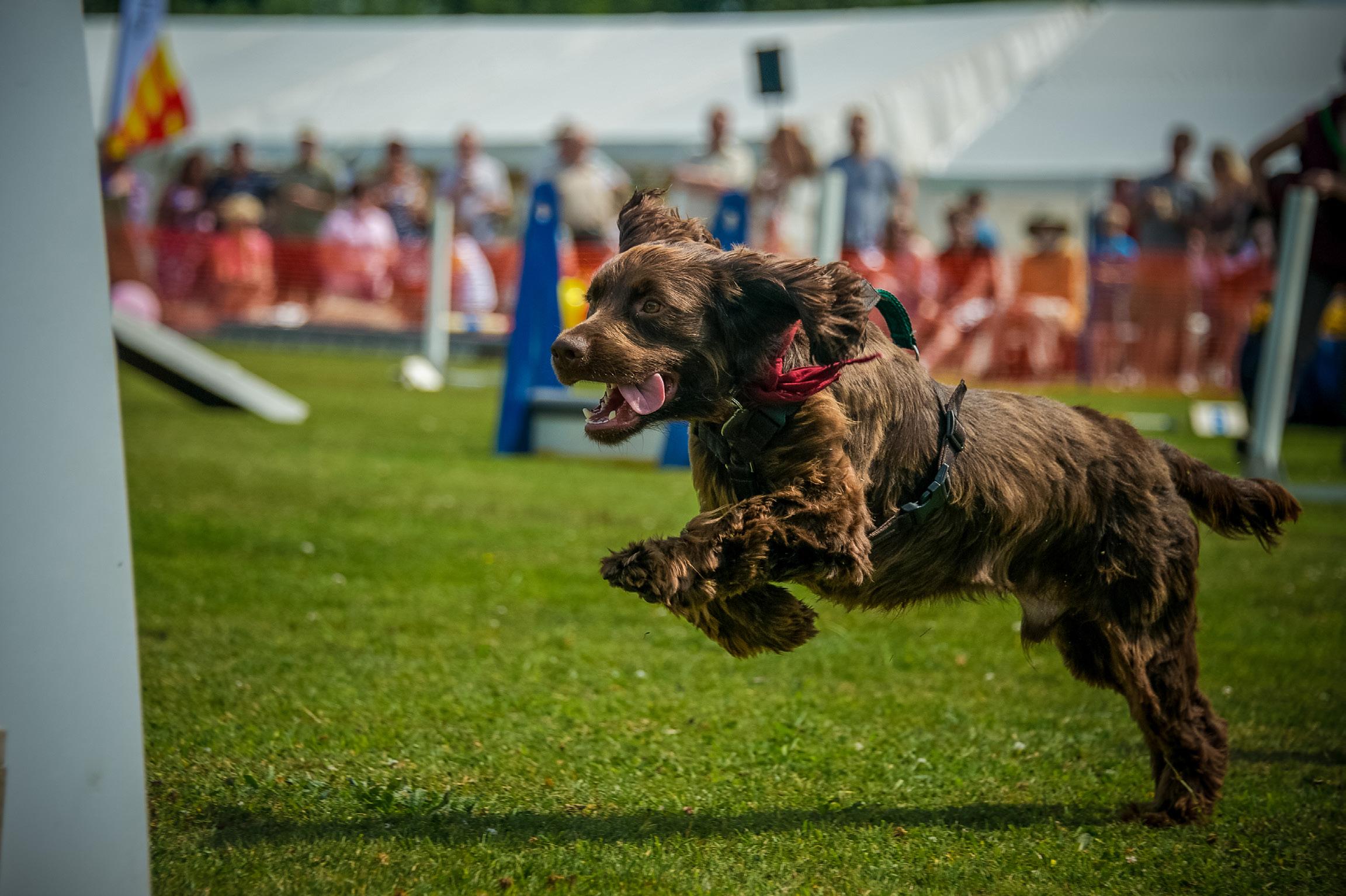
Four dogs are shortlisted for the Award by judges from the Kennel Club in the February preceding Crufts each year. They are chosen based on the lifetime of love and loyalty they give to their owners and the remarkable difference they make in society. The finalists share their stories, and the incredible impact their dogs have made on their lives, and then individuals within the UK can cast their votes over the month. The four finalists attend Crufts, and a winner is announced. The Kennel Club Charitable Trust awards £5,000 to the winner to be donated to a dog charity of their choice, while the other finalists each get £1,000 for the same purpose.
THE MOST SUCCESSFUL GROUPS OF DOGS IN THE HISTORY OF CRUFTS 'BEST IN SHOW'
Gundog - 26 wins
Terrier - 22 wins
Utility - 13 wins
Hound - 12 wins
Pastoral - 6 wins
Working - 5 wins
Toy - 4 wins
DQ | 8C 34
SHOW DOGS
This year's winner was four-year-old Vesper, a Belgian Malinois, who was the Extraordinary Life of a Working Dog finalist with her owner and handler, Niamh Darcy. Vesper was previously named Venom and had been deemed unsuitable as a police dog, as despite excelling in all other areas, she also excelled in cuddling criminals! Niamh, a dog handler from Merseyside Fire and Rescue, took a chance on the 18-month-old Vesper, and she performed perfectly in a
trial under adverse conditions, and the pair bonded instantly. In 2023, the pair were deployed on a rescue mission following the devastating earthquakes in Turkey and Morocco, where they worked tirelessly to locate survivors trapped under the rubble!
Be sure to keep a look out on the Crufts pages early next year if you are after some amazingly heart-warming and tear-jerking stories about our favourite four-legged heroes!
SHOW DOGS

DQ | 8C 35

WHY IS THE AMERICAN XL BULLY BEING BANNED?
IN ENGLAND, SCOTLAND AND WALES
DQ | 8C 36 NEWS
Rules restricting ownership of American XL Bully dogs are now in force in England, Wales and Scotland.
WHAT IS AN AMERICAN XL BULLY?
An XL bully is the largest kind of American bully dog. Other types include standard, pocket and classic. The UK Government published guidance to help identify XL Bullies, which are not recognised as a specific breed.
The guidance describes them as "large dogs with a muscular body and blocky head, suggesting great strength and power for [their] size". Male XL dogs stand at least 51cm high at the shoulder, with female XLs only slightly smaller. Dogs in England, Scotland and Wales will be considered XLs if they meet the minimum height and possess some of a defined set of characteristics.

HOW DOES THE AMERICAN XL BULLY BAN WORK IN ENGLAND AND WALES?
Ownership of American XL Bully dogs is restricted under the Dangerous Dogs Act 1991. Since December 31st 2023, it has been against the law in these countries to sell, give away, abandon or breed from an XL Bully, and since February 1st this year, it has been a criminal offence to own an XL Bully without an exemption certificate. The government received more than 60,000 applications for exemption in advance of the deadline. Today, police can seize unregistered, prohibited dogs, and their owners face a criminal record and unlimited fine.
DQ | 8C 37 NEWS
WHAT DO OWNERS OF EXEMPT XL BULLIES HAVE TO DO?
Owners in England and Wales who applied for an exemption had to buy insurance, microchip their dog and pay a £92.40 fee per animal.
Registered dogs have to be housed securely, kept on a lead, and muzzled in public.
Older dogs must also be neutered by June 30th or by the end of 2024 for dogs under the age of one.
Owners in England and Wales can no longer apply to exempt an XL Bully.
Anyone choosing not to keep their XL Bully had to take it to a registered vet to be euthanised by January 31st 2024.
WHAT ARE THE RULES FOR AMERICAN XL BULLIES IN SCOTLAND?
Since February 23rd, American XL Bullies have had to be muzzled and kept on a lead in public in Scotland. It is illegal to abandon, rehome, sell, buy, or transfer ownership of an XL Bully in the country. Anyone who breaks the rules risks up to six months in prison and/or a fine of up to £5000 (approximately R100,000).
Owners who wish to keep their dogs will need to have - or have applied for - an exemption certificate by July 31st 2024.
The requirements for exempt XL Bully owners in Scotland are expected to mirror those in England and Wales.
There was an influx of dogs being rehomed to Scotland before the England and Wales bans took effect.

DQ | 8C 38 NEWS

DQ | 8C 39

DQ | 8C 40 NEWS

WHY DO SOME UK CHARITIES OPPOSE THE AMERICAN XL
BULLY BAN?
WHAT IS THE BASIS OF THE BAN?
There are no official statistics on attacks by individual dog breeds in the UK. When it announced the XL bully ban in England and Wales in late 2023, the government said 23 deaths had been caused by dog attacks since the start of 2021, "with the XL bully being disproportionately involved".
According to the Dog Control Coalition, breed-specific bans do not work and are unfair to responsible dog owners and their pets.
The body includes Battersea Dogs and Cats Home, the Dogs Trust, the Kennel Club, the RSPCA and the British Veterinary Association.
The group wants an overhaul of the Dangerous Dogs Act, including tougher penalties for owners who fail to control their dogs.
NEWS DQ | 8C 41

EMBRACING
DQ | 8C 42 DOG AT HOME
THE ART OF CARING FOR A SENIOR DOG
THE GOLDEN YEARS
As the years advance, our loyal canine companions slow down, their muzzles begin to turn grey, and their eyes carry the soft glow of wisdom accumulated over time. Senior dogs bring a quiet dignity to our homes, and with this shift in life stage comes the need for us to adapt our care to meet their changing requirements. Embracing the golden years of your dog involves a blend of love, attentiveness, and adjustments to their daily routine.
WHEN IS A DOG CONSIDERED A SENIOR?
A dog is generally considered senior when they reach the last third of their expected lifespan, which varies by breed and size. Small dogs might not show signs of aging as quickly as giant breeds, which can enter their senior years as early as six years old.
DQ | 8C 43 DOGS AT HOME

The following are all important in caring for your senior dog:
Health assessments: Regular veterinary check-ups become even more critical as your dog ages. Bi-annual health exams can catch early signs of common age-related conditions such as arthritis, dental disease, vision and hearing loss, kidney disease, or cognitive dysfunction. Senior dogs may also require more frequent blood tests, urinalysis, and other diagnostics to monitor their health closely.
Nutrition for the older canine: An older dog's metabolism slows down, necessitating a review of their diet. Senior-specific dog food formulations can provide the right balance of nutrients, lower calories to prevent weight gain, and supplements to support joint health. Consult your vet about the best diet plan, and consider integrating probiotics or omega-3 fatty acids to bolster their well-being.
DQ | 8C 44 DOG AT HOME

Comfort is key: As dogs age, their comfort becomes an even greater priority. Orthopaedic dog beds can relieve pressure on the joints, and ramps can assist dogs in navigating stairs or getting into cars. It is also important to keep them warm in the winter months and cool in the summer, as older dogs may struggle to regulate their body temperature.
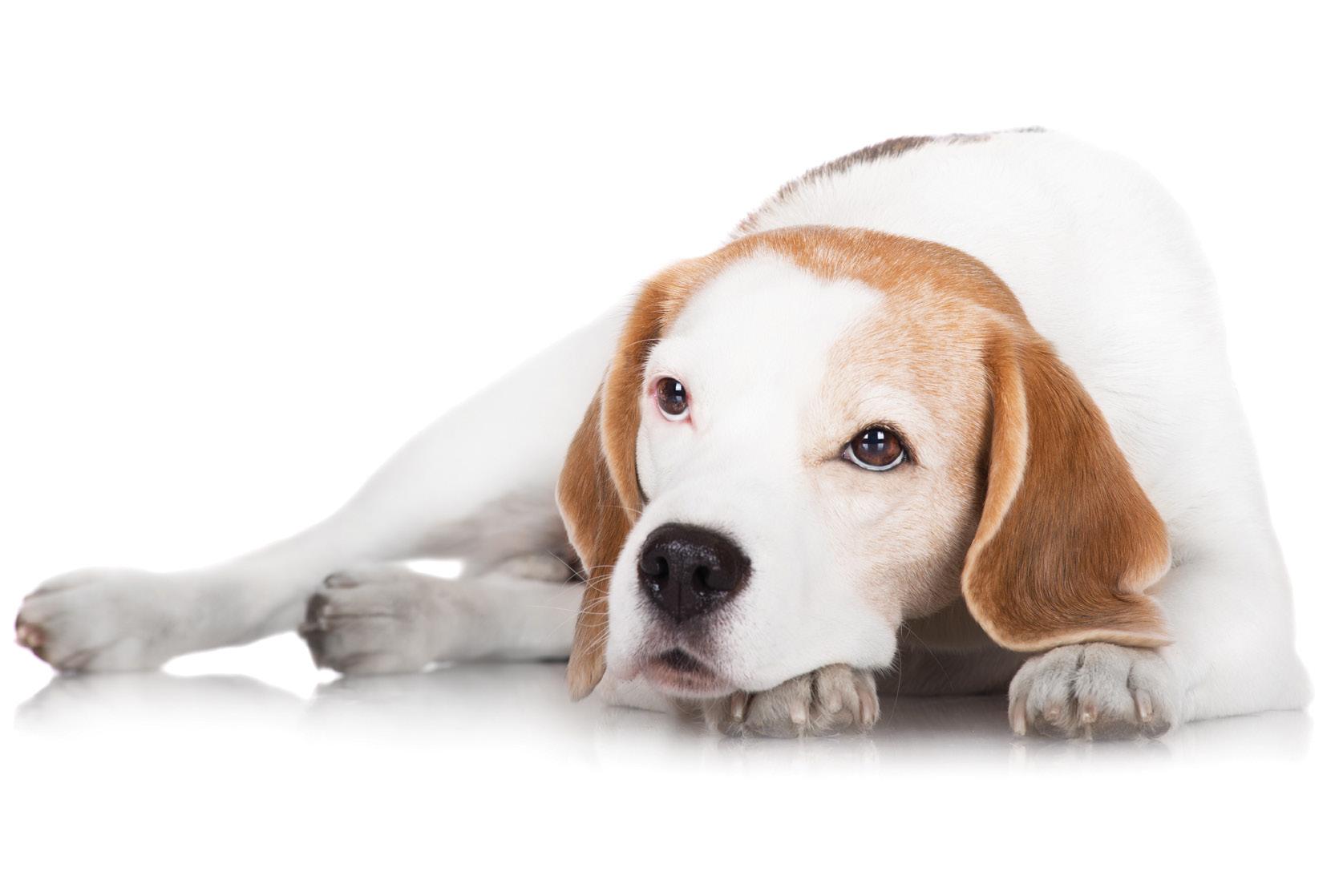
DQ | 8C 45 DOGS AT HOME
Exercise and mental stimulation: While high-impact activities may no longer be suitable, gentle exercise is essential for maintaining muscle tone and joint flexibility. Tailor the length and intensity of walks to your dog’s comfort level. Mental stimulation remains as vital as ever; interactive toys and simple training exercises can help to keep their mind sharp.
Special accommodations for sensory decline: Senior dogs often experience a decline in their senses. Accommodate potential vision and hearing loss by maintaining consistent routines and avoiding moving furniture around. Use hand signals along with verbal commands if their hearing is failing.

DQ | 8C 46 DOG
AT HOME

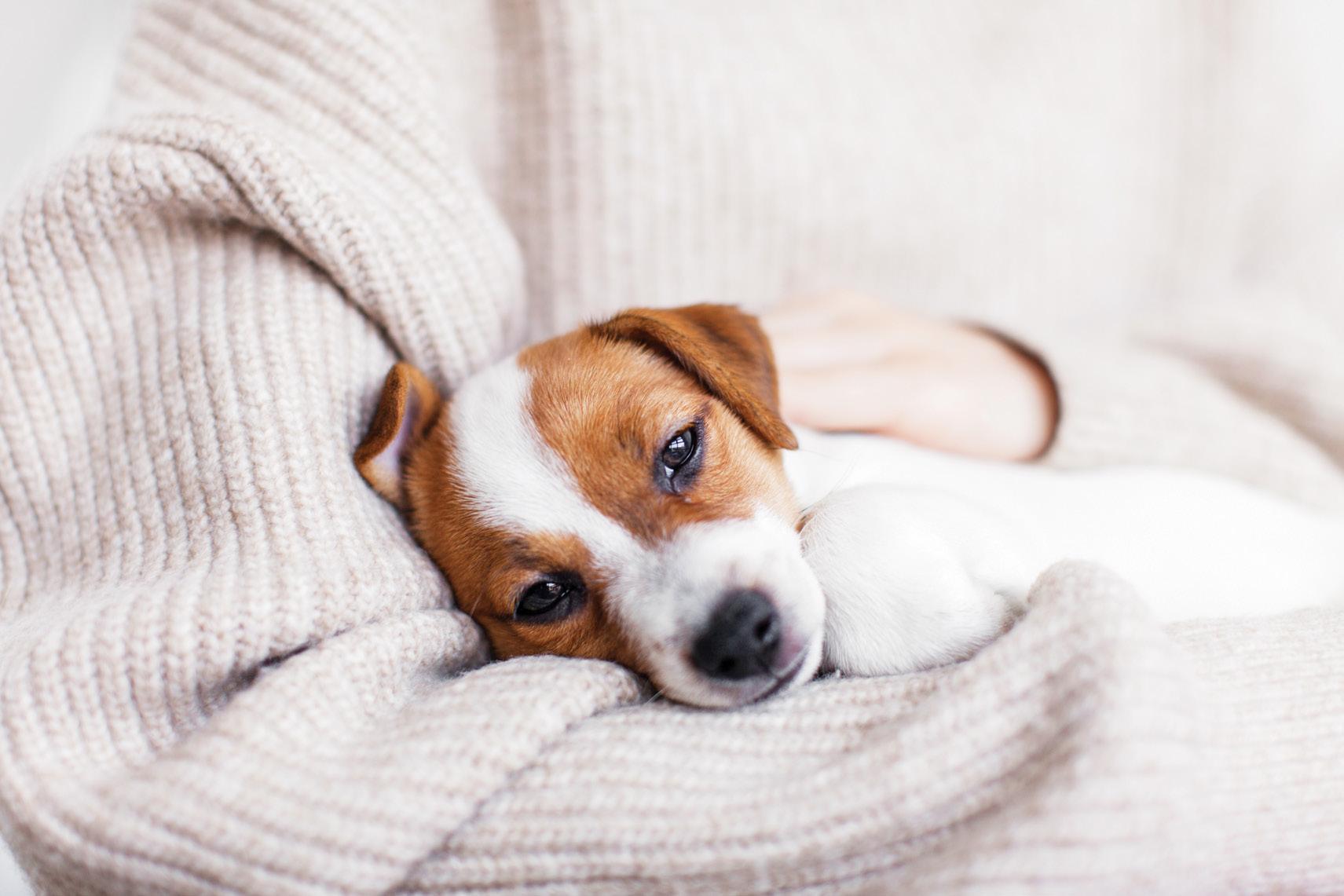
Pain management: Be vigilant about signs of discomfort, as senior dogs may suffer from chronic pain due to conditions like arthritis. Veterinaryprescribed medications, supplements, or alternative therapies like acupuncture can help to provide pain relief.
Emotional support: Senior dogs may seek more attention and reassurance as they age. Be patient with any anxiety or confusion they may show, and provide plenty of affection to reassure them of their place in the family.
DQ | 8C 47 DOGS AT HOME

Preparing for the end: As difficult as it is, part of caring for a senior dog is recognising when their quality of life is declining. Regularly discuss their health with your vet and consider a palliative care plan for ensuring their comfort in their final days.
DQ | 8C 48
DOG AT HOME

TAKE HOME MESSAGE
Caring for a senior dog is a tender and poignant journey. It's an opportunity to give back to our devoted companions who have enriched our lives through the years. By adjusting our care to suit their evolving needs, we ensure that their golden years are filled with dignity, comfort, and love. It’s not just about adding years to their life, but life to their years, making every moment count.
DQ | 8C 49 DOGS AT HOME

Parting paws
DQ | 8C 50 DOG AT HOME

ENSURING YOUR DOG'S WELLBEING WHEN YOU GO AWAY
DQ | 8C 51 DOGS AT HOME
The thought of leaving our beloved dogs behind while we jet off on holiday certainly tugs at the heartstrings. And, we all know, that ensuring our dog's well-being during our absence is not just about finding a place for them to stay; it's about making the separation as stress-free as possible for both of us.
PLAN FOR THEIR CARE
Start planning your dog’s care well in advance of your trip. You have several options:
1. Boarding kennels: Research reputable kennels with good reviews and health and safety certificates. Visit in person to assess cleanliness, space, and the demeanour of the dogs and staff. A trial stay before your holiday can help your dog adjust.
2. Pet sitters: Hiring a pet sitter to either stay in your home or visit regularly can maintain your dog’s routine. Ensure they’re experienced and have references.
3. Family or friends: Sometimes a familiar face can make all the difference. If someone your dog knows and trusts can look after them, this may be the ideal solution.

DQ | 8C 52
DOG AT HOME

PREPARE YOUR DOG
Gradually prepare your dog for the time apart. If they’re going to a kennel, let them have a short stay beforehand. For pet sitters or family, introduce them in advance and let them spend time together.
ENSURE THEIR COMFORT
Leave clear instructions about your dog’s diet, exercise routine, and any medications. Provide items that smell like you to comfort them, such as an unwashed shirt. Their favourite toys and bed will also help them feel at home.

DQ | 8C 53 DOGS AT HOME
PROVIDE DETAILED INFORMATION
Create a detailed care guide including:
• Feeding schedule and amounts
• Exercise routine
• Medical information and vet contact
• Behavioural quirks and how to handle them
• Emergency contacts
STAY CALM
Dogs can pick up on your emotional state, so keep goodbyes upbeat and calm to avoid causing them stress.
CHECK-IN:
Arrange to check in on your dog periodically if possible. Hearing your voice can reassure them, and updates can ease your mind.
CONSIDER A TEST RUN
If it’s your first time away, consider a short trip first to see how your dog copes and to ensure they’re in good hands.

COPING WITH SEPARATION
It’s normal to worry about your dog while you’re away. Trust that you’ve made the best arrangements for their care and use the time to recharge so you can return to your dog at your best.
DQ | 8C 54
DOG AT HOME

CONCLUSION
Leaving your dog when you go on holiday can be challenging, but thorough preparation can help ensure your pet’s well-being and peace of mind. Whether you choose professional boarding, a trusted sitter, or a friend or
relative, the key is finding what works best for your dog's individual needs. With careful planning, you can enjoy your time away, knowing that your dog is safe, cared for, and eagerly awaiting your return.
DQ | 8C 55
DOGS AT HOME
theUnravelling ofmysteries canine slumber
UNDERSTANDING YOUR DOG'S SLEEP PATTERNS
Many of us have marvelled at the ease with which dogs seem to drift into dreamland. Whether it's a peaceful nap in a sunbeam or a deep doze by their owner's feet, dogs have a unique sleep rhythm that supports their active lifestyles. In this article, we'll explore the intricacies of canine sleep, offering insights into why dogs sleep the way they do and how you can help your furry friend get the best rest possible.
DQ | 8C 56
DOG AT HOME

THE CANINE SLEEP CYCLE
Unlike humans, dogs have a polyphasic sleep pattern, meaning they have multiple rest periods within a 24-hour cycle. An adult dog typically requires 12-14 hours of sleep a day, while puppies and older dogs might need even more. This sleep is not continuous; dogs alternate between napping and activity throughout the day.
DQ | 8C 57
DOGS AT HOME

STAGES OF CANINE SLEEP
Dogs experience two main stages of sleep: slow-wave sleep (SWS) and rapid eye movement (REM). SWS is the initial phase where the dog's body relaxes, and brain activity slows. Following SWS, they enter REM sleep, where the brain becomes more active and dreaming occurs. Dogs spend less time in REM sleep than humans, so they need more frequent sleep periods.
FACTORS INFLUENCING SLEEP
Breed, age, activity level, and health all play roles in determining a dog's sleep needs. Larger breeds and those with high activity levels often require more sleep to recover. Additionally, puppies expend a lot of energy growing and learning, making ample sleep critical. Senior dogs, meanwhile, may sleep more due to lower energy levels or health issues.
DQ | 8C 58 DOG AT HOME

THE IMPACT OF SLEEP ON HEALTH
Sleep is as important for dogs as it is for humans, playing a crucial role in immune function, growth, brain health, and behaviour. Lack of sleep can lead to irritability and stress in dogs, just as it can in their human counterparts.
DQ | 8C 59 DOGS AT HOME

CREATING A SLEEP-INDUCING ENVIRONMENT
To promote quality sleep for your dog, consider the following tips:
Comfortable bedding: Invest in a comfortable dog bed. Consider orthopaedic beds for seniors or dogs with joint issues.
Routine: Establish a consistent daily routine that includes regular exercise, feeding, and bedtime. This predictability can help regulate your dog's sleep cycle.
Quiet space: Provide a quiet, safe space for your dog to sleep without disturbances from foot traffic or noise.
DQ | 8C 60
DOG AT HOME

Temperature: Dogs sleep best in a temperature-controlled environment. Avoid places that are too hot or cold.
Limiting evening stimulation: As bedtime approaches, avoid high-energy games that could raise your dog's adrenaline levels, making it harder for them to settle down.
Health check-ups: Regular veterinary care will ensure underlying health issues don't disrupt sleep.
DQ | 8C 61 DOGS AT HOME
RECOGNISING SLEEP DISORDERS
While less common than in humans, dogs can suffer from sleep disorders, such as insomnia, sleep apnoea, or narcolepsy. If your dog displays unusual sleep behaviours, like excessive daytime sleepiness, difficulty breathing while asleep, or sudden collapse during activity, consult your veterinarian.
CONCLUSION
Dogs may not sleep like we do, but their need for restful slumber is just as profound. By understanding and respecting your dog's natural sleep needs, you can help ensure that they remains healthy, happy, and wellrested.

DQ | 8C 62 DOG
AT HOME

DID YOU KNOW?
Bulldogs are not great swimmers and should not be put into water without a doggy life jacket. Their short legs, small hindquarters and bulky builds are simply not equipped to keep their large heads above water.
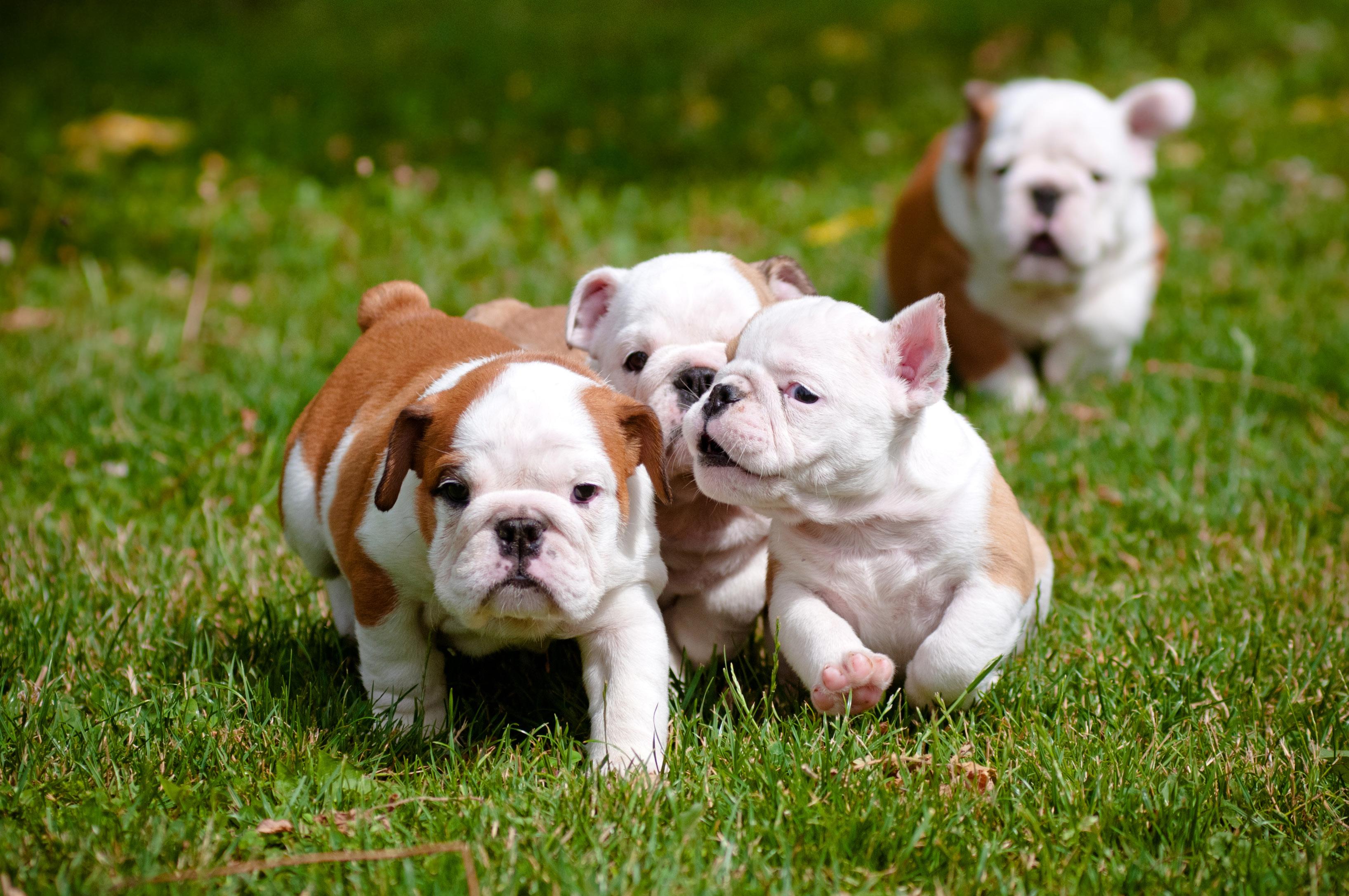
DQ | 8C 63
FOCUS

THE FREEDOM OF
DQ | 8C 64 ACTIVE DOG

HANDS-FREE
HOW TO CHOOSE AND USE A HANDS-FREE DOG LEAD
DQ | 8C 65
ACTIVE DOG

Ahands-free dog lead can be a game-changer for the active dog owner. It offers the freedom to multitask while ensuring your dog is safely by your side, whether you're jogging, pushing a pram, or just need your hands for a morning coffee. This innovative dog-walking tool has gained popularity recently, and we thought it was time we saw what all the fuss was about.
CHOOSING THE RIGHT HANDS-FREE LEAD
When selecting a hands-free dog lead, we'd advise you to consider the following:
1. Size and breed suitability: Make sure the lead is strong enough for your dog's size and breed. A sturdy, adjustable belt with a suitable clasp is essential for larger dogs, while smaller breeds might do well with a lighter set-up.
DQ | 8C 66 ACTIVE DOG

2. Length and flexibility: Look for a lead that offers enough length to give your dog freedom but not so much that you lose control. Some models come with bungee sections that provide extra give and help absorb the shock if your dog pulls.
3. Comfort: The belt should fit comfortably around your waist or across your body. Padding can provide additional comfort and help prevent rubbing.
4. Durability: High-quality materials will withstand the test of time and weather. Look for leads made from strong nylon or leather and durable hardware.
5. Safety features: Reflective stitching for nighttime visibility and sturdy, reliable clasps are essential. Some hands-free leads also have quick-release features for emergencies.
DQ | 8C 67 ACTIVE DOG

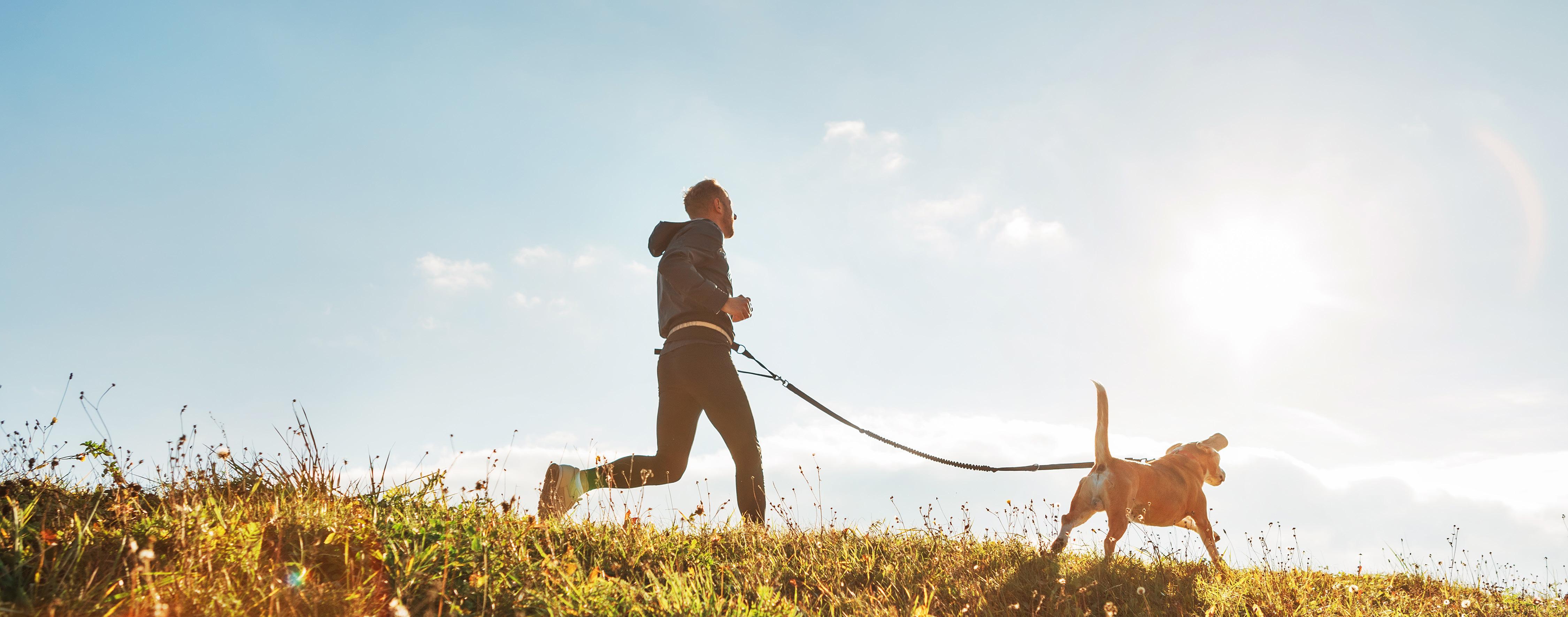
BENEFITS OF HANDS-FREE LEADS
The benefits of using a hands-free lead include:
• Improved posture: Without the need to hold a lead, you can maintain better posture while walking or running.
• Convenience: Keeps your hands free for other tasks or activities.
• Control: A hands-free lead wrapped around the waist can offer better control over your dog, distributing their pull across your centre of gravity.
• Bonding: Allows you to walk in tandem with your dog, fostering a sense of partnership.
TRAINING YOUR DOG FOR A HANDS-FREE LEAD
Before you hit the ground running, it's essential to train your dog to walk nicely on a hands-free lead. Start by introducing the lead during regular walks, letting them get used to the new range of motion. Ensure they know commands like 'heel' to keep them close and 'let's walk' to initiate movement. Patience and positive reinforcement will help make the transition smooth.
DQ | 8C 69 ACTIVE DOG

DQ | 8C 70 ACTIVE DOG
USING A HANDS-FREE LEAD SAFELY
Always remain aware of your surroundings, especially when your hands are busy. Keep an eye on your dog to ensure they're not getting into trouble or moving too far away from you.

OUR REVIEW
Our Canicross friends have long been advocating that we give hands-free a go, and whilst we were sceptical at first, we must admit that our first few forays with a hands-free setup have been life-changing. Around roads and busy areas (with cyclists, particularly!), the experience can be a bit daunting, and we definitely found ourselves grabbing the handsfree lead like a standard lead to get a bit more control, but out in the open and on the trails we've found the whole experience quite brilliant. We can't say we'll always opt for hands-free, but there's certainly a place for these leads, particularly for the well-trained canine!
FINAL THOUGHTS
A hands-free dog lead can significantly enhance the walking experience for both you and your dog. It's a fantastic tool for those who live an active lifestyle or simply want a more convenient way to accompany their furry friend on adventures.
DQ | 8C 71 ACTIVE DOG

DECODING THE CANINE PALATE
A DOG'S SENSE OF TASTE
DQ | 8C 72 DOG HEALTH

As dog owners, we often interpret our pets' eagerness to gobble down their meals as a sign of a voracious appetite. However, have you ever wondered how your furry friend experiences the taste of the food they seem to relish so much? While dogs are not gourmet connoisseurs by any stretch of the imagination, they possess a sense of taste that is fundamentally different to our own and equally fascinating.
DQ | 8C 73
DOG HEALTH

THE BASICS OF CANINE TASTE
Dogs have approximately 1,700 taste buds, a modest number compared to humans, who boast around 9,000. But what they lack in quantity, they make up for in specialisation. For example, dogs have taste buds attuned to water, a rare trait in the animal kingdom. These water-specific taste buds are located at the tip of the tongue, which is why you may notice your dog lingering over a refreshing drink of water.
THE FOUR TASTE CLASSIFICATIONS
Like humans, dogs can discern the four basic taste classifications – sweet, sour, salty, and bitter. Dogs have a particular fondness for sweet and meaty flavours, so many dog foods and treats have a significant meat component and may include carbohydrates that impart a sweet taste.
DQ | 8C 74 DOG HEALTH
CANINE PREFERENCES AND AVERSIONS
Dogs often display a marked preference for meat and fat, which aligns with their evolutionary heritage as hunters. This natural predisposition explains why dogs might turn their noses up at fruits and vegetables, though many will still enjoy them, especially if they carry a hint of sweetness.

Dogs generally have an aversion to intensely bitter or sour flavours, which can be a beneficial trait, as many toxic substances have a bitter taste.
DQ | 8C 75 DOG HEALTH

THE LINK TO SMELL
A dog's sense of taste is intimately connected to his sense of smell, and a dog's sense of smell is infinitely superior to our own. Smell plays a crucial role in a dog's ability to assess and enjoy food.
When a dog shows enthusiasm for a meal, it's often the aroma that's primarily engaging them, not the flavour itself. This is why dogs may lose their appetite when their sense of smell is compromised due to illness or age.
DQ | 8C 76 DOG HEALTH
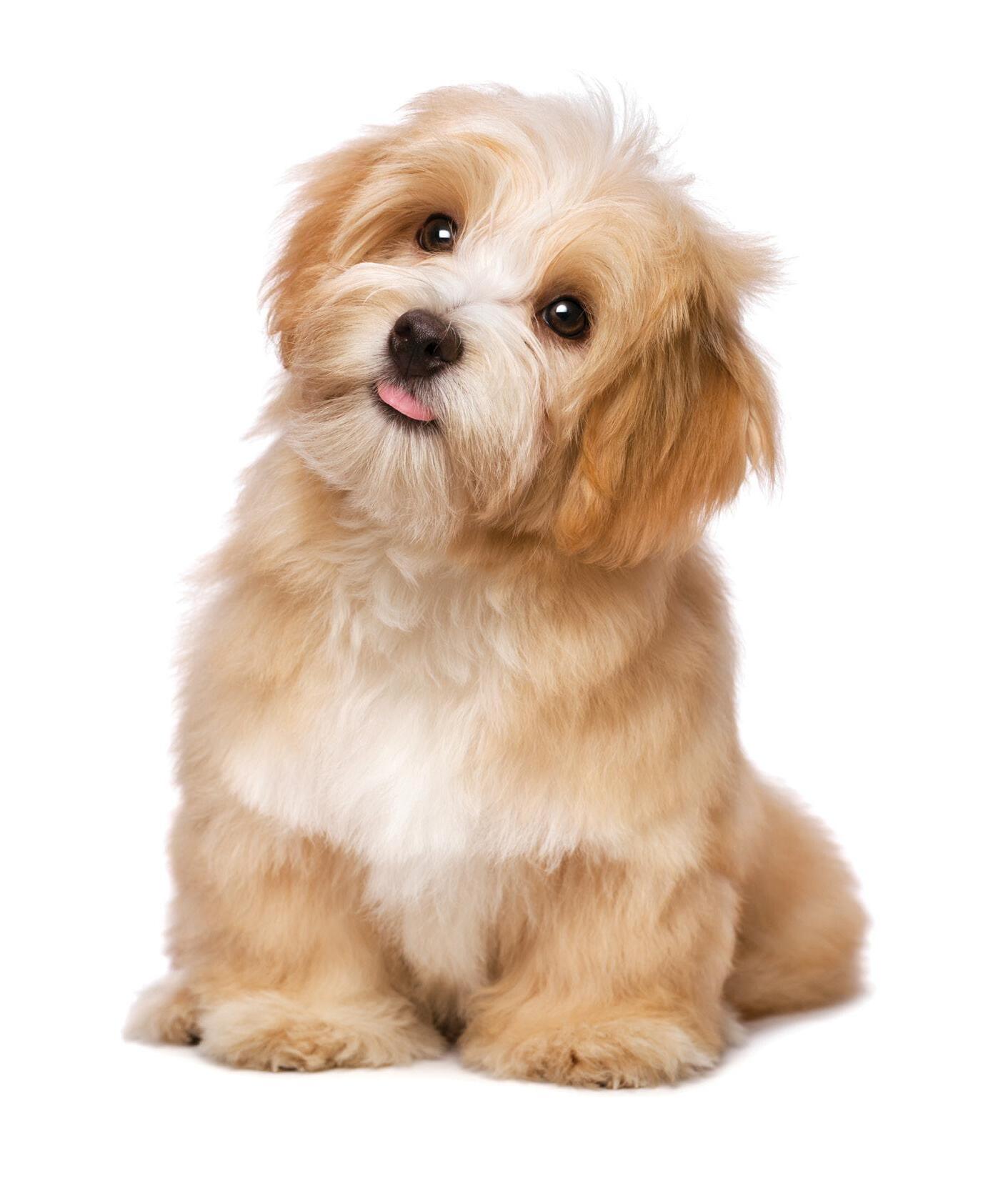
NOTE: INFLUENCE OF BREED AND INDIVIDUALITY
Breed may influence taste preferences, with some breeds being more predisposed to certain dietary habits. Moreover, individual dogs, much like people, have their own unique tastes. Some may crave variety, while others are content with a consistent diet.
IMPACT ON DIET AND NUTRITION
Understanding a dog's sense of taste can have practical implications for pet nutrition. While taste is important, it's vital not to sacrifice nutritional value for flavour alone. Balancing palatability with the proper nutrients is the key to a healthy diet for dogs. For picky eaters, enhancing the scent of food can often make it more appealing than attempting to adjust the taste.
TAKE HOME MESSAGE
A dog's sense of taste is a blend of evolutionary biology and sensory interplay, predominantly driven by their powerful sense of smell. While they may not savour flavours as humans do, taste still plays an important role in their overall food experience. For dog owners, acknowledging these taste preferences while maintaining a balanced diet is essential for the health and happiness of their canine companions.
DQ | 8C 77 DOG HEALTH
YOUR DOG QUESTIONS ANSWERED

Do certain dog breeds like to swim more than others?
Yes, certain dog breeds are more inclined to enjoy swimming than others, often due to their historical roles and physical attributes. Breeds that were developed for jobs requiring them to work in water tend to be natural swimmers. Here are some examples:
1. Labrador Retrievers: Bred as waterfowl retrieving dogs, they have water-resistant coats and webbed feet, making them excellent swimmers.
2. Golden Retrievers: Similar to Labradors, they were also bred for retrieving and are known to love water.
3. Portuguese Water Dogs: As their name suggests, these dogs were bred to work in the water, helping fishermen by herding fish into nets.
4. Newfoundland: This large breed has a waterresistant coat and webbed feet, and they were originally used as working dogs to help haul nets for fishermen and rescue people at risk of drowning.
DQ | 8C 78
?
5. Chesapeake Bay Retrievers: Known for their love of water, this breed has an oily coat that provides excellent insulation and water resistance.
6. Spanish Water Dog: They have been used for herding and as fishermen's assistants. They are natural and enthusiastic swimmers.
7. Standard Poodles: Despite their reputation as show dogs, Standard Poodles were originally bred as water retrievers and love to swim.
8. Irish Water Spaniel: This breed is the largest of the spaniels and was specifically bred to retrieve game from water.
9. American Water Spaniel: Developed in the United States as a hunting dog, the American
10. Otterhounds: With their webbed feet and dense, oily double coat, Otterhounds were originally bred for hunting otters in rivers and ponds.
Breeds not traditionally associated with swimming, particularly those with heavy bodies and short legs (like Bulldogs or Dachshunds), may not take to water as naturally due to their physical build. Additionally, brachycephalic breeds (like Pugs and Boxers) may have difficulty keeping their noses above water because of their short muzzles.
Regardless of breed, it's essential to gradually introduce any dog to water and ensure safety with a life vest if they are learning to swim or are unsure swimmers. Some dogs may have individual preferences and fears, so not all dogs

DQ | 8C 79 Q&A

Why do some dogs eat their own faeces or those of other dogs?
Dogs eating their own faeces, a behaviour known as coprophagia, can be both a natural and unnatural behaviour, depending on the context and frequency. Here are several reasons why dogs may engage in this activity:
1. Puppy exploration: Puppies are naturally curious and explore the world with their mouths. They may eat faeces out of curiosity or to learn about their environment.
2. Nutritional deficiency: A dog might eat faeces if he lacks certain nutrients in his diet. The behaviour can sometimes indicate that the dog is trying to replenish enzymes so he can digest his food better.
3. Malabsorption issues: If a dog has a nutritional deficiency, he may consume faeces to attempt to gain those missed nutrients.
4. Health issues: Certain conditions, such as diabetes, thyroid disease, and parasites, can increase appetite. Dogs with these conditions may eat faeces and other inappropriate items to satiate themselves.

DQ | 8C 80 Q&A
5. Cleanliness: Some dogs, especially mothers with puppies, will eat faeces to keep their den clean. This is a natural behaviour meant to protect the puppies from predators that might be attracted to the scent.
6. Boredom or anxiety: Dogs that are bored or anxious may eat faeces as a way to alleviate stress or occupy their time.
7. Habit: If a dog starts eating faeces for any of the above reasons, the behaviour can sometimes become a habit over time.
8. Attention-seeking behaviour: Some dogs may learn that they receive attention when they eat faeces – even if the attention is negative, such as their owner scolding them.
9. Learned behaviour: Dogs can pick up behaviours from watching other dogs. So if they
see another dog eating faeces, they might copy this action.
10. Confinement: Dogs kept in small areas or cages, who are not able to defaecate away from their living space might eat their faeces to keep their living area clean.
11. Taste: Some dogs might actually like the taste of faeces. This can be because some dogs might only partially digest the food, and the faeces may not taste all that different from the kibble, especially to a dog.

If a dog regularly eats faeces, it is important to consult with a vet to rule out health problems and seek advice on how to address the behaviour. Additionally, keeping the dog’s living area clean, ensuring a healthy diet, and providing plenty of exercise and mental stimulation can help prevent this behaviour.
DQ | 8C 81 Q&A
Products we love
Shopping fun
PaleoPet Pure 100% Green Beef Tripe for Dogs
Humans may find tripe to be somewhat of an acquired taste (and smell), but dogs absolutely love it! Our tripe has been thoroughly washed and cleaned for you, while retaining all the nutrition of unbleached tripe. It’s easy to serve and store and has so many health benefits for adult and senior dogs especially.
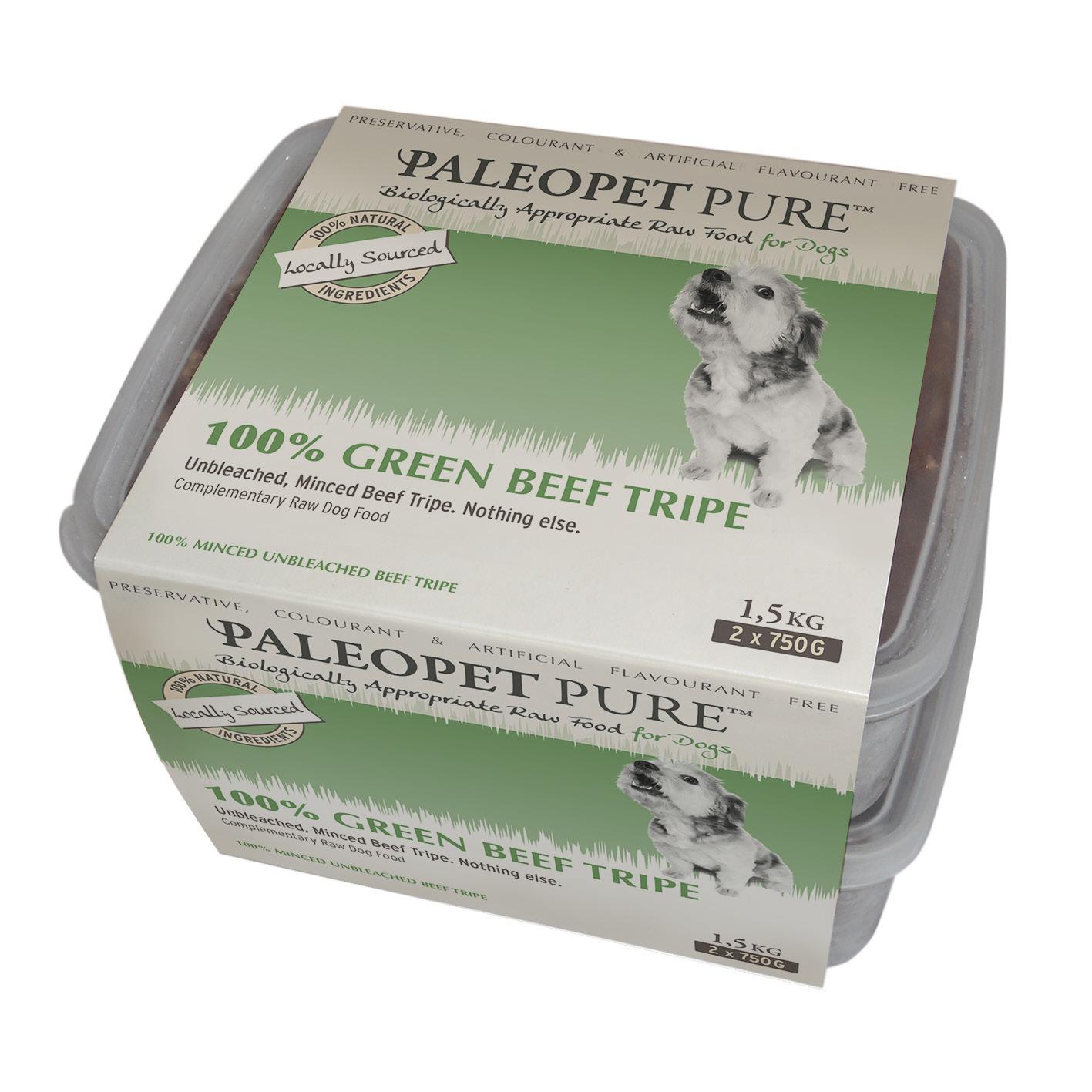
to no carbohydrate, moderate protein and high fat. Tripe can also entice dogs who may not feel all that well and are reticent to eat.
Our 100% Green Beef Tripe (and nothing else) is made from the best quality local beef with no preservatives, colourants or artificial flavourants.
Tripe is rich in trace minerals, while moderate in protein and fat. It is a great complementary raw food addition to a diet for dogs who may struggle with constipation or need foods that are easier to digest.
Tripe doesn’t contain any bone, but still maintains a perfect calcium phosphorus balance, which is rare for animal protein without bone content.
Tripe can be used as a basis for a ketogenic diet for dogs with cancer or epilepsy where one should feed low
The PaleoPet Pure range is FSA Food Safety certified and DALRRD registered. Also available in convenient, pre-frozen 1,5 Kg and 750g tubs or as a box of 12 individually wrapped 100g Patties. The tubs are reusable, recyclable and PBA-free.
Products can be purchased online at www.paleopetpure.com and delivered to your door or bought at selected retailers.
DQ | 8C 82
follow us on Instagram @dogquarterlymag and Facebook dqmagazine stay tuned for the next issue of
DQ | 8C 84 WWW.DQMAGAZINE.CO.ZA Next magazine issue of available 15 April 2024

